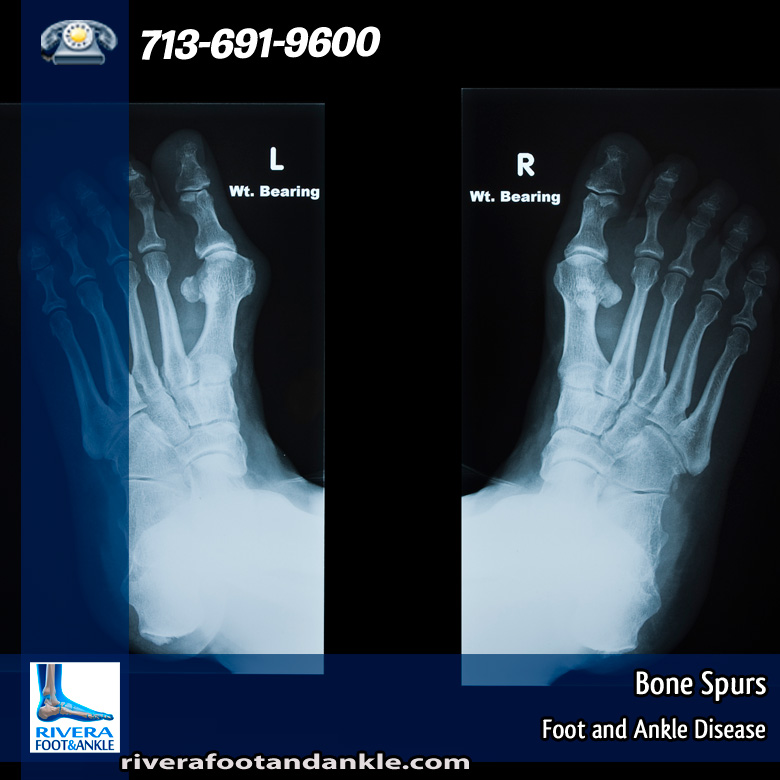Bone Spurs
Foot and Ankle Disease
Bone spurs are bony projections that develop along the edges of bones. Also called osteophytes, bone spurs often form where bones meet each other in your joints. Bone spurs can also form on the bones of your spine.
The main cause of bone spurs is the wear-and-tear damage associated with osteoarthritis. Most bone spurs cause no symptoms and may go undetected for years. Bone spurs may not require treatment. Decisions about treatment depend on where spurs are located and how they affect your health.
Most bone spurs cause no signs or symptoms. Often you don't even realize you have bone spurs until an X-ray for another condition reveals the growths. In some cases, though, bone spurs can cause pain and loss of motion in your joints.
Specific symptoms depend on where the bone spurs are located. Examples include:
- Knee. Bone spurs in your knee may make it painful to extend and bend your leg. The bony growths can get in the way of bones and tendons that keep your knee operating smoothly.
- Spine. Bone spurs on your vertebrae can narrow the space that contains your spinal cord. These bone spurs can pinch the spinal cord or its nerve roots and may sometimes cause weakness or numbness in your arms or legs.
- Hip. Bone spurs can make it painful to move your hip, although the pain is sometimes referred down to your knee. Depending upon the placement, bone spurs also can reduce the range of motion in your hip joint.
- Shoulder. Bone spurs can rub on your rotator cuff, a group of muscles and tendons that help control your shoulder movements. This can cause swelling (tendinitis) and tears in your rotator cuff.
- Fingers. Appearing as hard lumps under your skin, bone spurs can make the joints in your fingers look knobby.
When to see a doctor
Make an appointment with your doctor if you have pain or swelling in one or more joints or if you have difficulty moving a joint. Early treatment can help prevent or slow further joint damage.
Wear-and-tear arthritis (osteoarthritis) is the most common cause of bone spurs. As osteoarthritis breaks down the cartilage cushions the ends of your bones, your body attempts to repair the loss by creating bone spurs near the damaged area. The extra bone may help increase the amount of surface area for load bearing.
Bone spurs can break off from the larger bone, becoming what doctors call loose bodies. Often bone spurs that have become loose bodies will float in your joint or become embedded in the lining of the joint (synovium).
Loose bodies can drift into the areas in between the bones that make up your joint, getting in the way and causing intermittent locking a sensation that something is preventing you from moving your joint. This joint locking can come and go as the loose bodies move into and out of the way of your joint.
Source: mayoclinic
RIVERA FOOT & ANKLE: At Orlando H.Rivera DPM, our priority is to deliver quality care to informed patients in a comfortable and convenient setting. When you have problems with your feet, you need to turn to a podiatrist who listens and responds… an experienced doctor who knows the field and can effectively diagnose and treat your needs… a friendly physician who counsels you on the best ways to maintain and improve your health. Our physician(s) meet all these criteria. Plus, you benefit from a dedicated team of trained professionals who give you the individualized attention you deserve.

Treatment of Foot and Ankle
Keywords: Foot and Ankle, Dr. Orlando Rivera, Advanced Foot & Ankle Specialist, Foot and Ankle Podiatry, Houston Food & Ankle Surgical, Treatment of Foot and Ankle, Foot & ankle specialists, Podiatrist in houston, podiatrist in houston, Orlando H.Rivera DPM, Houston Foot Doctor, Food and Ankle Surgeon Houston, Ankle and Foot Specialist Houston, Podiatrist Houston, Foot Pain Houston



